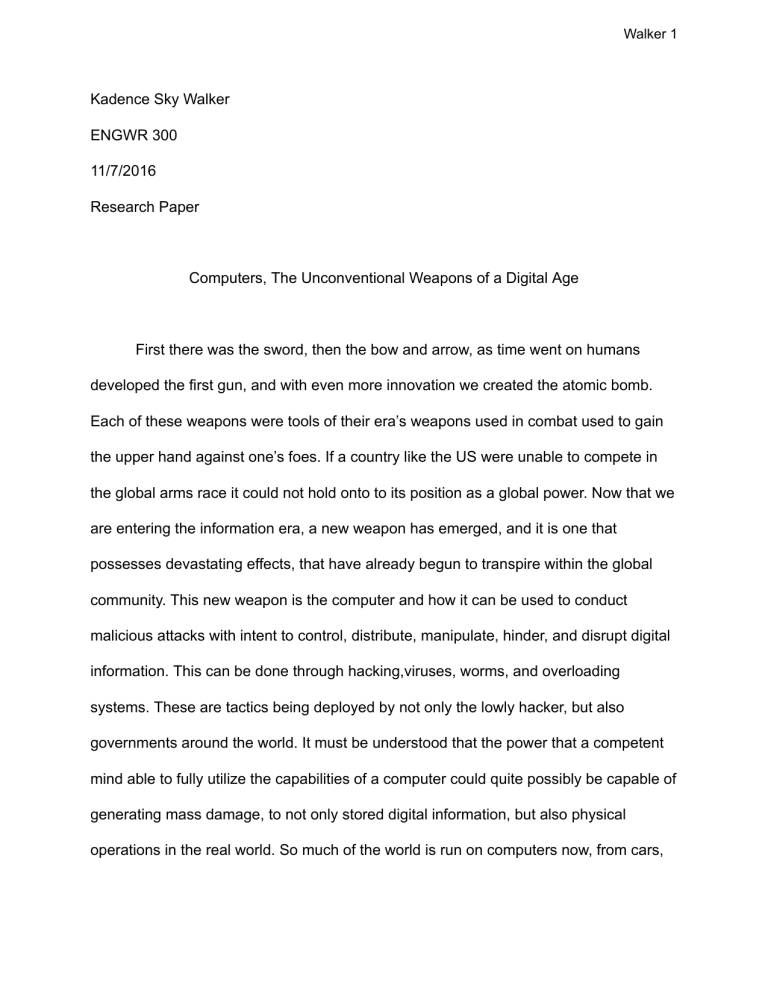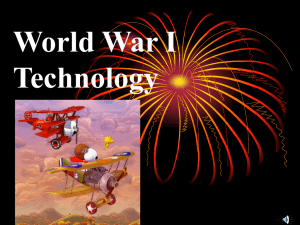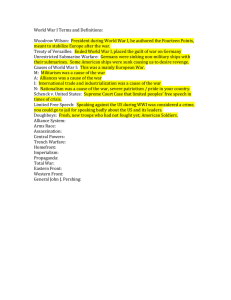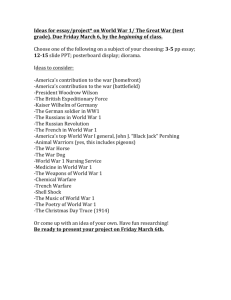
Walker 1 Kadence Sky Walker ENGWR 300 11/7/2016 Research Paper Computers, The Unconventional Weapons of a Digital Age First there was the sword, then the bow and arrow, as time went on humans developed the first gun, and with even more innovation we created the atomic bomb. Each of these weapons were tools of their era’s weapons used in combat used to gain the upper hand against one’s foes. If a country like the US were unable to compete in the global arms race it could not hold onto to its position as a global power. Now that we are entering the information era, a new weapon has emerged, and it is one that possesses devastating effects, that have already begun to transpire within the global community. This new weapon is the computer and how it can be used to conduct malicious attacks with intent to control, distribute, manipulate, hinder, and disrupt digital information. This can be done through hacking,viruses, worms, and overloading systems. These are tactics being deployed by not only the lowly hacker, but also governments around the world. It must be understood that the power that a competent mind able to fully utilize the capabilities of a computer could quite possibly be capable of generating mass damage, to not only stored digital information, but also physical operations in the real world. So much of the world is run on computers now, from cars, Walker 2 power, industry and manufacturing, even currency is becoming digital, all lacking proper digital protection. The discussion of the effects that technology has had on our lives has been one in circulation for quite some time. It comes up in talks about social media, news outlets and their trustability, and even the complete access of information that is provided through the internet. Quite often it will even be asked if our lives depend entirely too much on technology as we continue to move forward into the information era. Whether you feel that our lives are beginning to revolve too much around the internet, it does not change the fact that this trend of reliance on the information that exists on the web, looks as if it will continue. Digital information has become far more prevalent within our global community and will continue to rise in importance as digital information becomes a valuable resource. The ability to maintain a steady flow of such a commodity, has become that of great importance to governmental bodies. As such, the idea of digital warfare is being pushed to the forefront of the geopolitical discussion as digital information becomes more and more important. Likewise, digital warfare has become all the more prevalent in our world, not just at the civilian level, but also at the governmental and economic levels. Information warfare may seem like a simple and easy idea to grasp but it is actually a multi-leveled process in definition, which changes the more its participants discover about it and its uses. In Martin Libicki’s book, What is Information Warfare? he says “Coming to grips with information warfare... is like the effort of the blind men to Walker 3 discover the nature of the elephant: the one who touched its leg called it a tree, another who touched its tail called it a rope, and so on.” As such, digitais information warfare is commonly misperceived by many with its implications and practical uses. Digital informational warfare can be conducted in a variety of ways, all very reminiscent of that of previous wars. Digital information is merely the new medium in which operations such as espionage, counterIntelligence, and homeland security must now be conducted. Dr. Ivan Goldberg defines information warfare as: The offensive and defensive use of information systems to deny, exploit, corrupt, or destroy, an adversary’s information, information-based processes, information systems, and computer-based networks while protecting one’s own. Such actions are designed to achieve advantages over military or business adversaries. A recent example of how information warfare was used is the release of confidential emails during the 2016 US presidential election. When confidential emails were released of a presidential candidate in order to disrupt and manipulate the outcome of the US presidential election. The action not only revealed potentially sensitive documents from a government official (an act of digital information warfare in its own right), but also the releasing of this information to the general public caused mass hysteria. In 2010 there was an incident where a Iranian uranium enrichment plant was targeted by a cyber attack by some unknown assailant, assumed to be an opposing government. The malicious virus used in this cyber attack, on the Iranian plant’s Walker 4 systems came to be known as Stuxnet. This type of virus is known as a worm as it moves, attacks, and infects all on its own. Furthermore, the code used to create Stuxnet was highly developed and one of the first digital weapons ever used. This is because it wasn't intended to be solely a cyber attack that possibly rendered a governmental site out of service, this was an attack meant to achieve physical damage in the real world. As according to Kim Zetter in her book, Count Down to Zero Day, “Stuxnet as it came to be known, was unlike any other virus or worm built before: Rather than simply hijacking targeted computers or stealing information from them, it escaped the digital realm to wreak actual, physical destruction on a nuclear facility.” An attack such as this is so an great example of how digital warfare could easily be used to cripple the manufacturing industry of a country. Especially a country such as the US that relies heavily on manufactured goods. Furthermore, attacks could also be carried out against nuclear power plants, water treatment facilities, and even water dams, all of which often lack sufficient protection from digital invasion.Immense costs in damages would be achieved, that would not only result in economic loss but also could result in human casualties. Coordinated digital attacks such as this could easily render a country economically damaged, and fairly vulnerable. The capture and use of digital information in order to manipulate or alter the outcome of political affairs, and the use of digital attacks on industry and infrastructure, are two different ways digital information warfare can be used to achieve the user’s desired outcome. Walker 5 Just like any war the government has to be able to not only protect its citizens but also be able to launch offensive countermeasures against enemies. The types of offensive measures used do not differ greatly from those used within military tactics before the information era, only they are digital. This is war, and in war information is incredibly useful whether this is information from the enemy or even information coming from allied forces. Information collection is very necessary to continue to have the upper hand over one's enemy. With more information comes better understanding, which in turn brings better plans to take on opponents. Meaning fast and efficient transportation of information is paradigm to success. Information can be transported in a multitude of ways, composed of networks of computers, routers, telephone lines,cable, telephones, televisions, radios, and other data transport technologies. Without these appliances the transportation of digital information would be impossible. Transporting and maintaining control over information and who views it is also a very important defensive aspect of digital warfare. Typically, the goal is to to limit the amount of information the enemy can obtain. When it comes to the digital space the most common practices are hacking or disruption. Protection can be obtained through something as simple as password protection, or even virus protection software. Digital firewalls may also be implemented as they act as a kind of barrier stopping any unwanted access to what may lie behind it. So how might something like a government site be attacked in order to achieve the goal of disruption? Well a very commonly used tactic would be a very well Walker 6 coordinated “DDOS” attack which is an acronym for a Distributed Denial of Service attack. An attack such as a DDOS can render the servers of its target almost useless. This is because its point is to overload the systems of its receiver disabling it from accomplishing its directive. In this case we can assume that the prime directive is to store, receive, and send out crucial information. Meaning the attacker through a DDOS attack can reduce the rate at which information flows. Another very important part of warfare is the gathering of information. This can be accomplished through virus softwares like aforementioned Stuxnet or through hacking a system and using back doors or even deception through IP spoofing. A virus can be used in various means and can be implemented in various different ways. In Stuxnet’s case it's believed as to have been transferred through USB drives containing its software. All it takes is one person to insert the USB drives and Stuxnet has infected the system. Quite often the virus can be used how Stuxnet was but it can also act as a door allowing its controller to peer through at information contained within the infected system. Hacking a system and finding a back door can often be quite difficult but is not all to impossible. Often when we think of hacking we imagine it's some guy typing away on a keyboard endless streams of code . But in reality hacking can often be a robot trying to force its way into a system by password cracking. Password cracking is basically trying to guess a password over and over again thousands of times until the right password is achieved. A back door is often left behind in a system's security by a creator in order to easily maintain its operation. It is like having a door to the Walker 7 maintenance room instead of having to knock a hole through wall every time you need to fix something. Often people will forget how involved technology is within our everyday lives and the greater roles it continues to take on. Much of our lives are entwined deeply with technology and its use. There are people out there that seek to do harm to others and can easily use the advances of technology to wreak havoc on the way society operates. They can use tactics like disruption and manipulation in order to inhibit the flow of digital information and how it's used. That's why it's so incredibly important to know how to protect against digital invasion. Hopefully this paper has provided insight of how digital information is being used and to be aware of its applications as technology continues to take part in our lives. Walker 8 Resources: Hrovat, Eric. “Information Warfare: The Unconventional Art In A Digital World.” Https://Www.sans.org/, SANS Institute, 30 June 2001, www.sans.org/reading-room/whitepapers/warfare/information-warfare-unconventional-art-digi tal-world-787. Burns, Megan. “Information Warfare: What and How?” Information Warfare: What and How?, 1999, www.cs.cmu.edu/~burnsm/InfoWarfare.html. Bennett, Jonah. “WikiLeaks: ‘Corrupt Ruling Power Factions’ Are Going To Win The Election.” The Daily Caller, 20 Oct. 2016, dailycaller.com/2016/10/20/wikileaks-corrupt-ruling-power-factions-are-going-to-win-the-electi on/. Libicki, Martin C. What Is Information Warfare? Washington, D.C., National Defense University, Institute for National Strategic Studies, 1995. Zetter, Kim. Countdown to Zero Day: Stuxnet and the Launch of the World's First Digital Weapon. Broadway Books, 2014. Goodman, Marc. Future Crimes: inside the Digital Underground and the Battle for Our Connected World. New York, Anchor Books, a Division of Penguin Random House, LLC, 2016.



